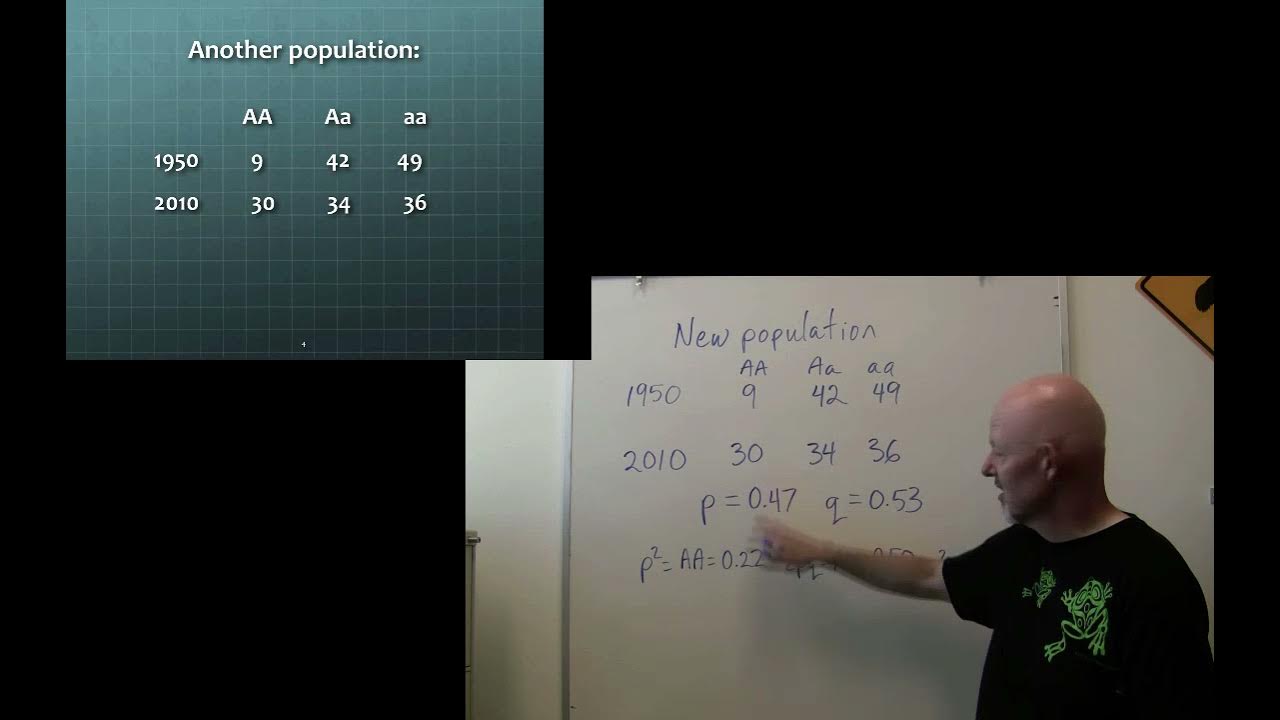Hukum Hardy & Weinberg
Summary
TLDRThis video explains Hardy-Weinberg's law, which states that gene frequencies in a population remain stable unless specific conditions, such as mutation, migration, random mating, population size, and natural selection, are disrupted. Using an example of a population with albinism, the presenter demonstrates how to calculate carrier and homozygous normal gene frequencies, applying Hardy-Weinberg equations to estimate percentages. The explanation emphasizes the significance of the formula, with a focus on understanding how genetic traits are passed down in a population. The video concludes with a note that the same principles apply to X-linked traits, to be covered in future content.
Takeaways
- 😀 Hardy-Weinberg's law explains that allele frequencies in a population will remain constant under certain conditions.
- 😀 Key conditions for Hardy-Weinberg equilibrium include no mutation, random mating, no large-scale migration, a large population size, and no natural selection.
- 😀 The Hardy-Weinberg equation is represented as p² + 2pq + q² = 1, where p and q represent allele frequencies of two alleles.
- 😀 P² represents the frequency of homozygous dominant individuals, 2pq represents heterozygous individuals, and q² represents homozygous recessive individuals.
- 😀 The example in the script involves albinism, a recessive genetic disorder represented by the allele 'a'.
- 😀 Individuals with albinism are homozygous recessive (aa), while carriers are heterozygous (Aa) and normal individuals are homozygous dominant (AA).
- 😀 To calculate the frequency of carriers, we use the formula 2pq, where 'p' is the frequency of the dominant allele and 'q' is the frequency of the recessive allele.
- 😀 In the example, 0.01% of the population has albinism, which is used to calculate the value of 'q'.
- 😀 Using q = 0.01, we find p = 0.99. The frequency of carriers (2pq) is then calculated as 0.0198, or 1.98%.
- 😀 The frequency of homozygous dominant (normal) individuals is calculated as p² = 0.99², which equals 98.01%.
Q & A
What is the Hardy-Weinberg law?
-The Hardy-Weinberg law is a mathematical model in population genetics that describes how allele frequencies in a population remain constant from one generation to the next, under ideal conditions.
Who were the key figures behind the Hardy-Weinberg law?
-The Hardy-Weinberg law is named after two key figures: G. H. Hardy, an English mathematician, and Wilhelm Weinberg, a German physician.
What are the five conditions necessary for Hardy-Weinberg equilibrium?
-The five conditions for Hardy-Weinberg equilibrium are: 1) No mutation, 2) Random mating, 3) No large-scale migration, 4) A large population size, and 5) No natural selection.
What is the general equation for the Hardy-Weinberg principle?
-The general equation for the Hardy-Weinberg equilibrium is: P² + 2PQ + Q² = 1, where P is the frequency of the dominant allele and Q is the frequency of the recessive allele.
What do the terms P², 2PQ, and Q² represent in the Hardy-Weinberg equation?
-In the Hardy-Weinberg equation: P² represents the frequency of homozygous dominant individuals (AA), 2PQ represents the frequency of heterozygous individuals (Aa), and Q² represents the frequency of homozygous recessive individuals (aa).
How is the Hardy-Weinberg principle used in population genetics?
-The Hardy-Weinberg principle is used to calculate the frequency of alleles and genotypes in a population, assuming no evolutionary forces are acting on the population.
In the example from the transcript, what genetic condition was used to explain Hardy-Weinberg's law?
-In the example, albinism, a recessive genetic condition, was used to explain how to calculate allele frequencies and carrier rates in a population.
How is the carrier frequency (heterozygous individuals) calculated in the Hardy-Weinberg example?
-The carrier frequency is calculated using the equation 2PQ, where P is the frequency of the dominant allele and Q is the frequency of the recessive allele. In the example, it was found to be 1.98%.
What is the importance of the Hardy-Weinberg equilibrium in genetics?
-The Hardy-Weinberg equilibrium provides a baseline for studying genetic variation in populations and helps identify when evolutionary forces like mutation, migration, or natural selection are affecting the population.
How is the Hardy-Weinberg equilibrium affected by real-world factors like mutation or migration?
-In real-world populations, factors such as mutation, migration, and natural selection often disrupt the Hardy-Weinberg equilibrium, leading to changes in allele frequencies over generations.
Outlines

Cette section est réservée aux utilisateurs payants. Améliorez votre compte pour accéder à cette section.
Améliorer maintenantMindmap

Cette section est réservée aux utilisateurs payants. Améliorez votre compte pour accéder à cette section.
Améliorer maintenantKeywords

Cette section est réservée aux utilisateurs payants. Améliorez votre compte pour accéder à cette section.
Améliorer maintenantHighlights

Cette section est réservée aux utilisateurs payants. Améliorez votre compte pour accéder à cette section.
Améliorer maintenantTranscripts

Cette section est réservée aux utilisateurs payants. Améliorez votre compte pour accéder à cette section.
Améliorer maintenantVoir Plus de Vidéos Connexes

110 Allele and Genotype Frequencies

Genetics Step 1 — Hardy-Weinberg Law — Boards and Beyond

Frekuensi gen dalam populasi ( Hukum Hardy Weinberg )

110 Hardy Weinberg Equilibrium

Discussions of conditions for Hardy Weinberg | Biology | Khan Academy

Population Genetics: When Darwin Met Mendel - Crash Course Biology #18
5.0 / 5 (0 votes)
